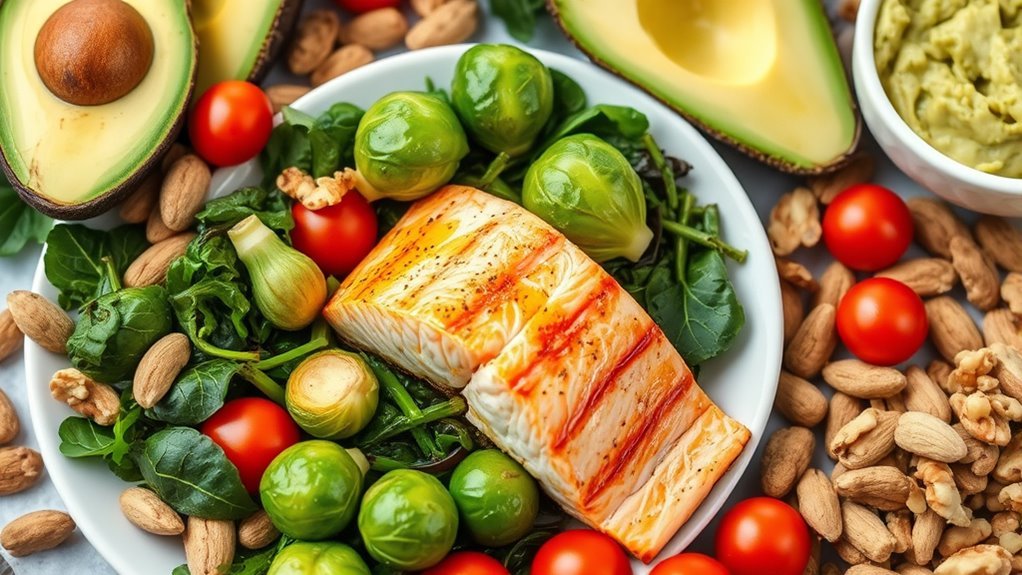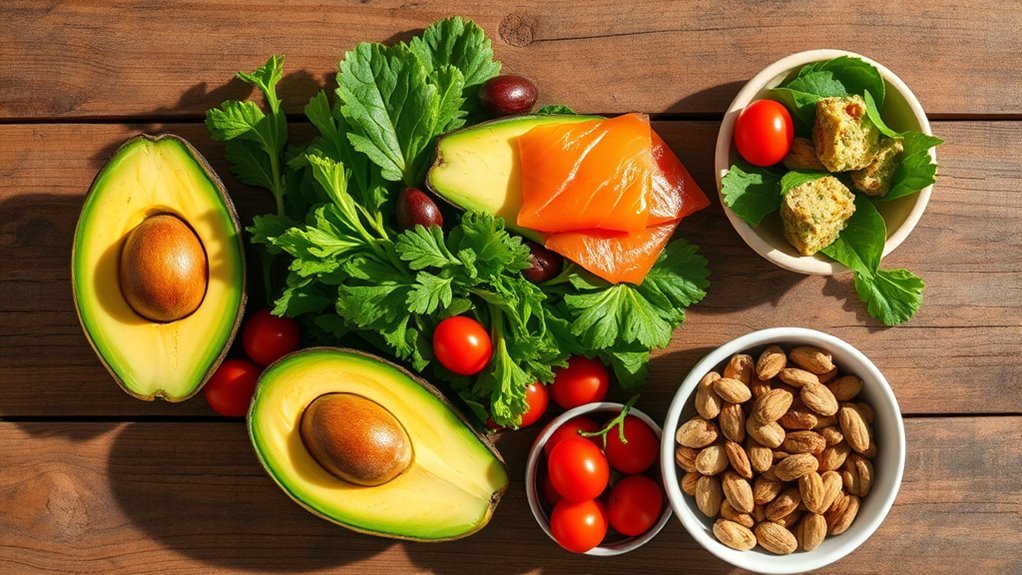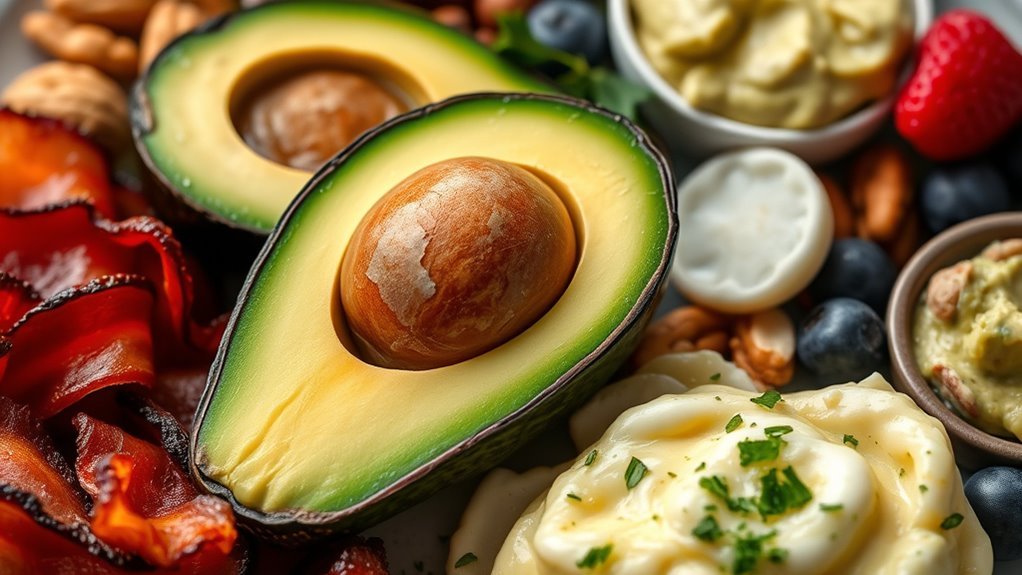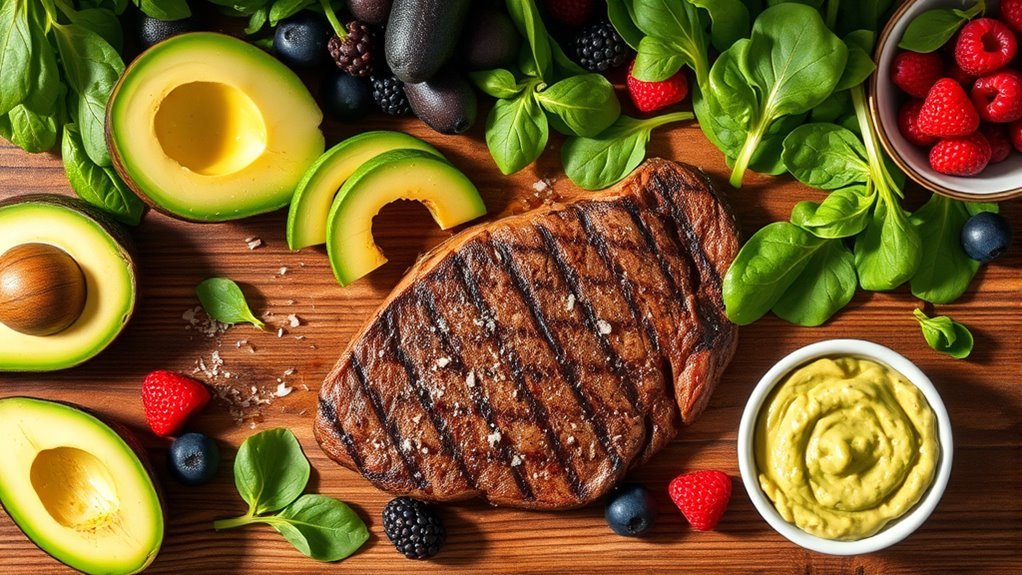Keto food primarily includes low-carbohydrate options that encourage your body to enter ketosis, a state where it burns fat for energy instead of glucose. You’ll consume healthy fats like avocados and olive oil, moderate protein sources such as eggs and fatty fish, and low-carb vegetables like spinach and broccoli. Avoid high-carb foods like bread and pasta, as well as most fruits. To discover more about the benefits and planning a successful keto diet, keep exploring.
Understanding the Ketogenic Diet

While many diets come and go, the ketogenic diet has gained significant attention for its potential benefits in weight management and metabolic health. At its core, the ketogenic lifestyle emphasizes low carbohydrate intake, encouraging your body to enter a state of ketosis, where it burns fat for fuel instead of glucose. This shift can lead to increased energy levels and reduced cravings. Effective keto meal planning is essential; it involves strategically selecting high-fat, low-carb foods like avocados, nuts, and fatty fish. By embracing this approach, you can enjoy greater flexibility in your eating habits while still achieving your health goals. Remember, the key is balance and sustainability, allowing you to maintain this lifestyle without feeling restricted or deprived.
The Science Behind Ketosis

Ketosis is a metabolic state where your body shifts from using glucose as its primary energy source to burning fat instead. This process not only helps in weight management but also offers various health benefits, including improved mental clarity and reduced inflammation. Understanding how ketosis works can empower you to make informed dietary choices that align with your goals.
Ketosis Explained Simply
Understanding ketosis is key to grasping how the ketogenic diet works. When your body enters ketosis, it shifts from burning glucose for fuel to burning fat. This metabolic state can lead to ketosis benefits like weight loss, improved energy levels, and better mental clarity. However, there are ketosis challenges to evaluate, such as the initial adjustment period known as the “keto flu,” where you might experience fatigue or irritability. Staying hydrated and maintaining electrolyte balance can help ease these symptoms. Ultimately, understanding these aspects enables you to navigate the ketogenic diet more effectively, empowering you to make informed choices and embrace this lifestyle with confidence and freedom.
Metabolic State Overview
As your body shifts into ketosis, it undergoes significant metabolic changes that alter how it generates energy. This state enhances your metabolic flexibility, allowing your body to efficiently switch between using carbohydrates and fats for energy production.
Here are some key aspects of this metabolic shift:
- Increased fat oxidation: Your body starts breaking down stored fats for fuel.
- Ketone bodies: These molecules become a primary energy source, sparing glucose.
- Lower insulin levels: This helps facilitate fat burning and improves overall metabolism.
- Altered hunger hormones: You may feel less hungry, aiding in appetite control.
- Enhanced mitochondrial function: Your cells can produce energy more efficiently.
Understanding these changes can empower you to make informed decisions about your dietary choices.
Benefits of Ketosis
When your body enters ketosis, it releases several health benefits supported by scientific research. These ketosis benefits extend beyond weight loss, enhancing mental clarity, and potentially improving insulin sensitivity. By understanding these keto advantages, you can make informed decisions about your lifestyle.
| Keto Advantages | Scientific Evidence |
|---|---|
| Weight Loss | Studies show reduced appetite and fat loss rates. |
| Enhanced Mental Clarity | Ketones provide a more efficient energy source. |
| Stabilized Blood Sugar Levels | Improved insulin sensitivity is often observed. |
| Increased Energy Levels | Many report higher energy and reduced fatigue. |
Embracing ketosis can lead to a healthier, more energetic life. By exploring these benefits, you can access your full potential while enjoying greater freedom in your food choices.
Key Components of Keto Food

When following a keto diet, understanding the key components of your food choices is essential. You’ll want to focus on low-carbohydrate foods, healthy fat sources, and a moderate protein intake to maintain ketosis. Each of these elements plays a vital role in achieving your nutritional goals while supporting overall health.
Low-Carbohydrate Foods
Although many diets emphasize the importance of carbohydrates, low-carbohydrate foods are essential for those following a ketogenic lifestyle. By reducing carb intake, you can encourage your body to enter ketosis, burning fat for fuel instead of glucose. Here are some great low-carb options to explore:
- Leafy greens, like spinach and kale
- Cruciferous vegetables, such as broccoli and cauliflower
- Nuts and seeds for satisfying low-carb snacks
- Eggs, a versatile and protein-rich choice
- Keto friendly desserts made with almond flour or coconut flour
Incorporating these foods can help you maintain energy levels and feel fulfilled. Embracing low-carb options not only supports your keto goals but also allows for delicious meal variety. Enjoy the freedom of flavorful, nutritious choices!
Healthy Fats Sources
Healthy fats are a cornerstone of the ketogenic diet, and incorporating them into your meals can greatly enhance your overall health. You’ll find numerous delicious options that provide essential nutrients.
| Healthy Fats | Benefits | Examples |
|---|---|---|
| Avocado | Rich in fiber and potassium | Guacamole, salads |
| Olive Oil | Heart-healthy monounsaturated fats | Dressings, cooking |
| Coconut Oil | Medium-chain triglycerides | Baking, coffee |
| Nuts Varieties | High in protein and healthy fats | Almonds, walnuts |
| Cheese Options | Calcium and protein source | Cheddar, mozzarella |
| Fatty Fish | Omega-3 fatty acids | Salmon, mackerel |
| Seeds Benefits | Packed with fiber and minerals | Chia, flaxseeds |
| Butter Types | Flavorful fat source | Grass-fed, clarified |
Incorporate these fats for a balanced and fulfilling keto experience!
Moderate Protein Intake
Moderate protein intake is essential for maintaining the delicate balance of the ketogenic diet. You don’t want to overdo it on protein, as too much can kick you out of ketosis. Instead, focus on finding the right protein balance. Here are some great protein sources to take into account:
- Grass-fed beef and lamb
- Wild-caught fish and seafood
- Pasture-raised poultry and eggs
- Plant-based options like tofu and tempeh
- Low-carb dairy products like cheese and Greek yogurt
Incorporating these protein sources wisely helps support muscle mass and overall health while keeping your body in fat-burning mode. Remember, moderation is key, so listen to your body’s needs, and you’ll thrive on your keto journey!
Health Benefits of a Keto Diet
While many diets promise quick results, the ketogenic diet stands out due to its unique approach to nutrition and its potential health benefits. One of the most appealing aspects is keto weight loss, which can occur as your body shifts to burning fat for fuel. You might also experience improved keto mental clarity, as ketones produced during ketosis are known to enhance brain function.
Here’s a quick overview of some key benefits:
| Benefit | Description | Evidence |
|---|---|---|
| Weight Loss | Promotes fat burning | Various studies |
| Mental Clarity | Enhances cognitive function | Research findings |
| Reduced Inflammation | May help lower chronic inflammation | Scientific reviews |
Exploring these benefits can empower your journey toward better health.
Common Misconceptions About Keto
Many people hold misconceptions about the ketogenic diet, which can lead to confusion and misinformation. Understanding the truth can help you navigate the keto lifestyle more effectively. Here are some common keto myths:
- Carb confusion: Not all carbs are created equal; some can fit into a balanced keto plan.
- Fat fear: Healthy fats are essential; they fuel your body and support nutritional balance.
- Protein paradox: Too much protein can kick you out of ketosis—moderation is key.
- Keto flexibility: The diet can be tailored to your preferences, allowing for ketogenic variations.
- Common pitfalls: Ignoring personal experiences may lead to challenges in lifestyle integration.
Foods to Eat on a Keto Diet
When you’re following a keto diet, focusing on low-carb vegetables and healthy fat sources is essential. These foods not only help you maintain ketosis but also provide crucial nutrients your body needs. Incorporating options like leafy greens, avocados, and olive oil can enhance your meals while keeping your carb intake in check.
Low-Carb Vegetables
Incorporating low-carb vegetables into your keto diet is essential for maintaining nutritional balance while keeping carbohydrate intake in check. These non-starchy options are packed with vitamins, minerals, and fiber, making them perfect for your meals. Plus, they help you feel full without derailing your keto goals.
Consider adding these keto friendly greens to your plate:
- Spinach
- Kale
- Zucchini
- Broccoli
- Cauliflower
These vegetables not only complement your favorite dishes but also provide essential nutrients without the carbs. Remember, the key is to focus on low-carb options that nourish your body while allowing you the freedom to enjoy delicious meals that align with your keto lifestyle. Embrace the variety and keep it fresh!
Healthy Fats Sources
While you might think that cutting carbs is the only focus of the keto diet, healthy fats play an essential role in achieving your nutritional goals. Incorporating avocado benefits, for instance, provides monounsaturated fats that support heart health. Explore nut varieties like almonds and walnuts, which offer protein and fiber. Olive oil and coconut oil are excellent choices for cooking and dressing due to their healthy fat content. Dairy sources like cheese and grass-fed butter are delicious fat options, while ghee alternatives can enhance flavor without compromising your diet. Don’t forget about seed options, such as chia and flaxseed, and fatty fish like salmon, which contribute omega-3s and have positive health impacts. Embrace these foods for a satisfying keto experience!
Foods to Avoid on a Keto Diet
To successfully adhere to a keto diet, you need to be mindful of certain foods that can derail your progress. Avoiding the following can help you maintain ketosis and reach your goals:
- High carb foods: Bread, pasta, and rice can quickly spike your carb intake.
- Processed foods: Often packed with hidden sugars and unhealthy fats, these can sabotage your efforts.
- Fruit choices: Many fruits are high in sugar; opt for low-sugar options instead.
- Grain alternatives: Even gluten-free grains can affect ketosis, so choose wisely.
- Sugar substitutes: Some can still impact insulin levels, so read labels carefully.
Staying aware of these items allows you to enjoy keto friendly snacks while optimizing your dietary freedom.
Meal Planning for a Successful Keto Journey
Successfully charting a keto diet involves not only avoiding high-carb foods but also planning meals that align with your goals. Meal prep is essential for success. Start by creating a grocery list filled with low-carb staples, ensuring you’re budget-friendly. Consider portion control to maintain your macros, and explore recipe ideas that offer meal variety for you and your family.
Here’s a simple weekly plan template:
| Meal Type | Options | Snack Ideas |
|---|---|---|
| Breakfast | Scrambled eggs, avocado | Cheese sticks |
| Lunch | Salad with chicken | Nuts |
| Dinner | Zucchini noodles | Hard-boiled eggs |
When dining out, choose dishes that fit your meal plan while enjoying the freedom of your keto journey.
Tips for Transitioning to a Keto Lifestyle
Shifting to a keto lifestyle can feel overwhelming at first, but with the right approach, you can make the change smoother and more enjoyable. Here are some tips to help you navigate effectively:
- Start with meal prep to plan your meals and snacks.
- Stock up on keto snacks like nuts, cheese, and veggies to curb cravings.
- Gradually reduce your carb intake instead of cutting it all at once.
- Stay hydrated and replenish electrolytes to avoid keto flu.
- Experiment with new recipes to keep your meals exciting.
Long-Term Sustainability of the Keto Diet
While the keto diet can offer significant short-term benefits for weight loss and metabolic health, maintaining it long-term requires careful consideration and commitment. You may face keto sustainability challenges, such as social situations, cravings, and nutritional balance. To combat these, it’s crucial to develop long-term adherence strategies. Incorporating a variety of keto-friendly foods can help prevent boredom and guarantee you’re meeting your nutritional needs. Allowing occasional flexibility, like a planned carb refeed, can ease the psychological burden. Engaging with a supportive community can also provide motivation and accountability. Ultimately, focusing on what makes you feel good and healthy will empower you to adhere to the keto lifestyle sustainably, assuring you enjoy the freedom that comes with balanced nutrition.


